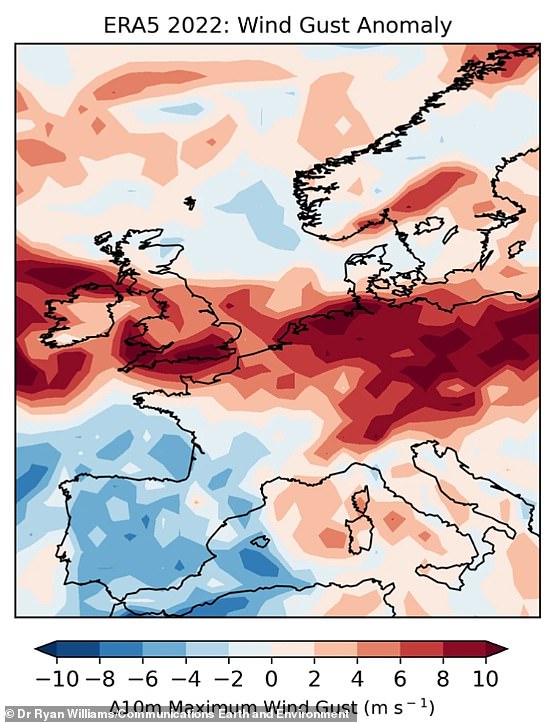Devastating winter storms that led to deaths and power outages across the UK and Ireland were driven by an intense swirling vortex of winds miles above the Arctic, scientists have revealed.
In February 2022, a trio of storms – named Dudley, Eunice and Franklin – hit the nation within the space of a week.
Four people lost their lives and 1.4 million households were left without electricity as record wind gusts of 122mph were recorded.
There was widespread flooding, panels were ripped off the roof of the O2 Arena in London and dramatic footage showed trees being brought down across the country.
It was the first time three named storms were recorded within a seven-day period since the storm-naming system began in 2015.
Now, experts have discovered that the cluster was connected to stronger winds in the Arctic stratosphere.
Researchers from the University of Leeds have found there was an extremely strong stratospheric polar vortex (SPV) – a large spinning mass of cold air in the stratosphere around 15 miles above the Arctic – at the time.
They say this made it up to three times more likely there would be intense storms affecting the UK and northern Europe during that month.

Devastating winter storms that led to deaths and power outages across the UK and Ireland were driven by an intense swirling vortex of winds miles above the Arctic, scientists have revealed. Pictured: map showing monthly maximum wind gusts for central-western Europe during February 2022, when the trio of storms battered the UK

A woman died in Muswell Hill, north London, after a tree fell onto a car she was travelling in during strong winds from Storm Eunice

Waves crashed over Newhaven Lighthouse and the harbour wall in East Sussex as Storm Eunice hit Britain

Parts of the O2 roof, formerly known as the Millennium Dome, were shredded by the strength of Storm Eunice’s winds
Such a strong SPV increased the likelihood of three or more storms reaching the UK in a single week by around 80 per cent compared to when the SPV was normal, they added.
Lead author Dr Ryan Williams, who carried out the research while at the University of Leeds, said: ‘Our research demonstrates the need to better understand the different drivers of the North Atlantic storm track, such as the state of the stratospheric polar vortex that is potentially predictable several weeks in advance.
‘Being able to provide early warnings of possible severe weather is all the more pertinent with climate change, as there is evidence that major winter storms will become more intense, exacerbating impacts such as flooding and wind damage.’
The signal for a strong SPV was evident from forecasts carried out as early as November 2021 – and spotting these conditions could offer a ‘window of opportunity’ for being able to better predict these storms, the team said.
It could help weather forecasters to know when there is an increased risk of storm clusters up to a month before they happen.
Co-author Jeff Knight, the Science Lead in Monthly to Decadal Prediction at the Met Office, said: ‘It’s been understood for a while that the Arctic stratosphere can affect the type of winter we get in the UK, but these results show that it can even affect the occurrence of stormy spells within the season.
‘An intense stratospheric polar vortex can now be recognised as a warning to forecasters of increased risks of damaging storms.
‘This was likely seen in the most recent winter, around the time of storm Eowyn in late January.’

Strom Eunice sent garden furniture flying across the country. Pictured: A trampoline in the air in Builth Wells in Wales

Members of the public braced the wind and wet weather in Westminster in central London during the storms in February 2022
Storm Dudley was the first of the three to hit in February 2022, making landfall in the UK on the 16th, and resulted in the loss of power for thousands of homes across parts of Cumbria, Yorkshire and Lancashire.
Storm Eunice, which arrived on the 18th February, was described as a ‘once in a decade’ event and the most severe since 2014 with record wind gusts for England of 122 miles per hour recorded at the Needles on the Isle of Wight.
It caused the death of a woman in her 30s in London, a man in his 20s in Hampshire, and a man in his 50s in Merseyside.
The storm’s fierce winds toppled trees and sent debris flying. The top of the spire at St Thomas’s Church in Wells, Somerset, was seen tumbling to the ground.
It also caused chaos for transport, forcing train operators to suspend services and the cancellation of dozens of flights across the UK.
The strong winds from Storm Franklin, which arrived on February 20th hampered the clean-up operations following Storm Eunice.
Heavy rainfall caused rivers to rise and forced some residents to evacuate their homes.
The findings of the new study were published in the journal Communications Earth and Environment.
This article was originally published by a www.dailymail.co.uk . Read the Original article here. .


